What Are Niche Edits? Do Niche Edits Work for SEO?
Sep 10, 2024
Written by Casey Bjorkdahl

Casey Bjorkdahl is one of the pioneering thought leaders in the SEO community. In 2010, Casey co-founded Vazoola after working for a Digital Marketing Agency for five years in New York City. Vazoola is now one of the fastest growing and most widely recognized SEO marketing firms in the country.
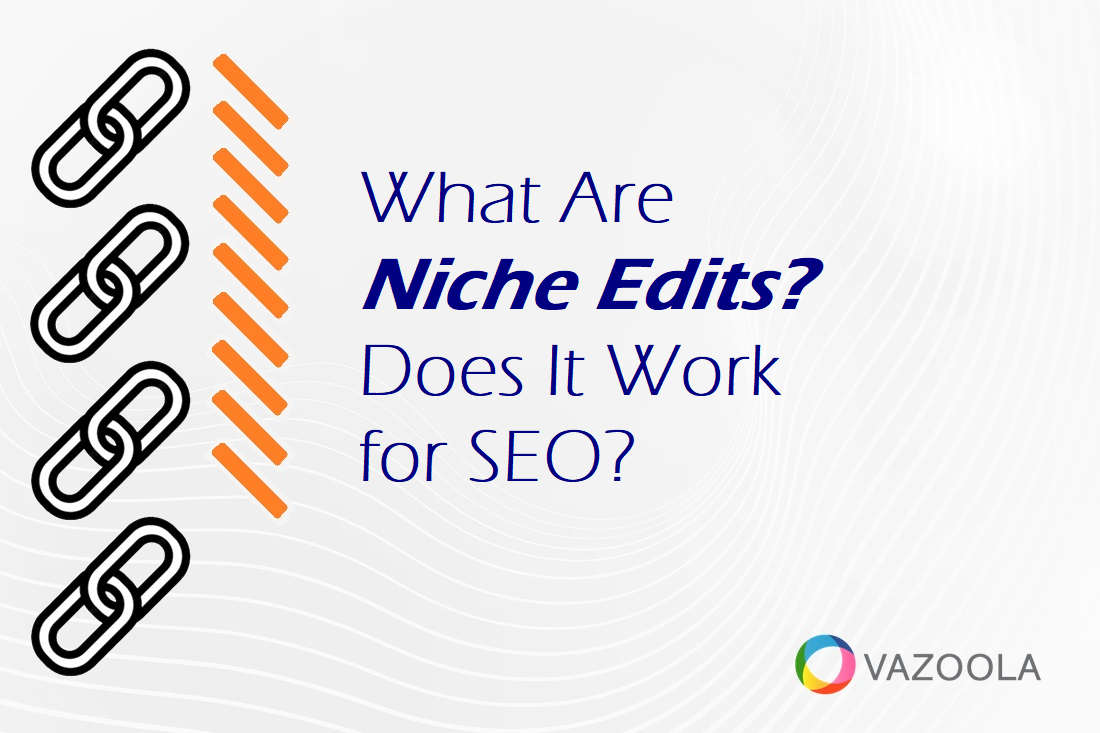
Niche edits, also known as curated links, are a powerful tool for boosting SEO strategies.
But what are these coveted connections, and how do you go about getting them?
When it comes to digital marketing, standing out is about more than just creating quality content. You need smart link-building strategies that elevate your website's authority and search engine rankings.
It’s true that niche edits can significantly impact your site's visibility. A well-placed link within an existing, high-authority article can substantially boost your site's credibility and improve your search rankings.

At Vazoola, we offer niche edits as part of our link-building SEO services. We bring expert insights into how these links work and how they can benefit your business.
Ready to take advantage of niche edits and launch your SEO efforts to new heights? Stay with us as we examine the specifics of niche edits, their types, and best practices to maximize your SEO efforts.
Key Takeaways:
-
Niche edits are obtained by adding links to existing, high-authority content, enhancing your site's visibility and authority in search engines.
-
Prioritize pages with numerous backlinks and strong SEO metrics like domain authority and URL rating.
-
Tools such as Ahrefs, SEMrush, and Moz Link Explorer can help identify high-value pages.
-
Make sure the content where your link will be placed is highly relevant to your website.
-
Maintain a diverse anchor text profile to avoid appearing spammy and to target a broader set of keywords. Use a mix of exact match, partial match, branded, and generic terms for natural link growth.
-
Regularly secure niche edits to improve and sustain your search engine performance.
Table of Contents:
Defining Niche Edits
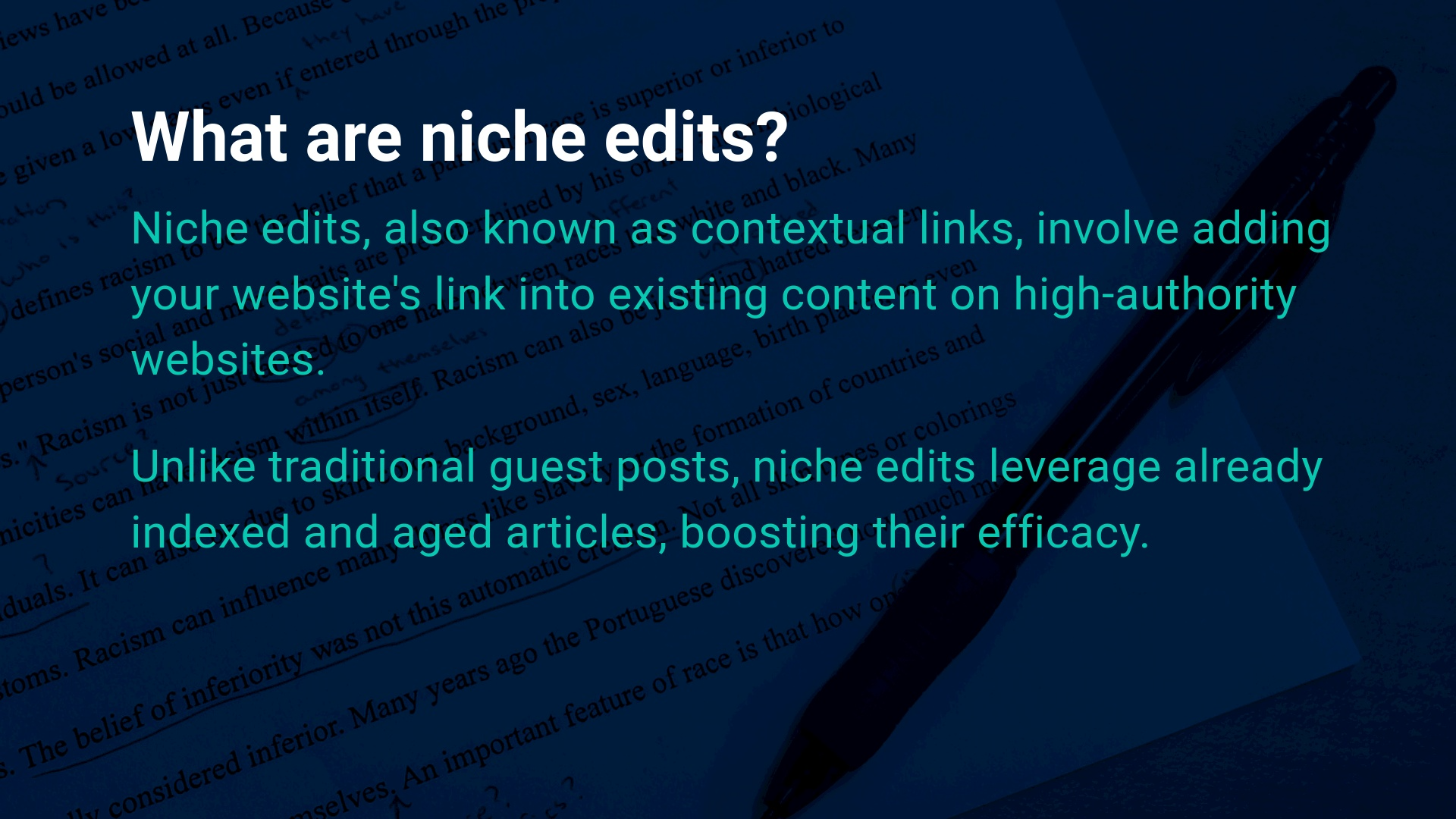
So, what are niche edits?
Also known as contextual links, link edits are made by adding your website's link into existing content on high-authority websites.
Unlike traditional guest posts, niche edits leverage already indexed and aged article. This boosts their efficacy.
For example, say a blog post about fitness on a reputable health site mentions various workout routines. A niche edit could seamlessly insert a link to your fitness equipment store within the relevant section.
But do niche edit links work?
Strategic placement within contextually relevant content helps improve your site's authority and its search visibility. As a result, niche edits are a valuable weapon in any SEO arsenal.
Pro Tips:
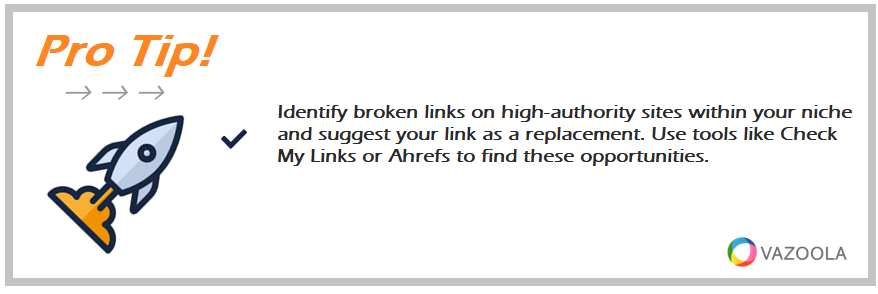
Identify broken links on high-authority sites within your niche and suggest your link as a replacement. Use tools like Check My Links or Ahrefs to find these opportunities.
Types of Niche Edits
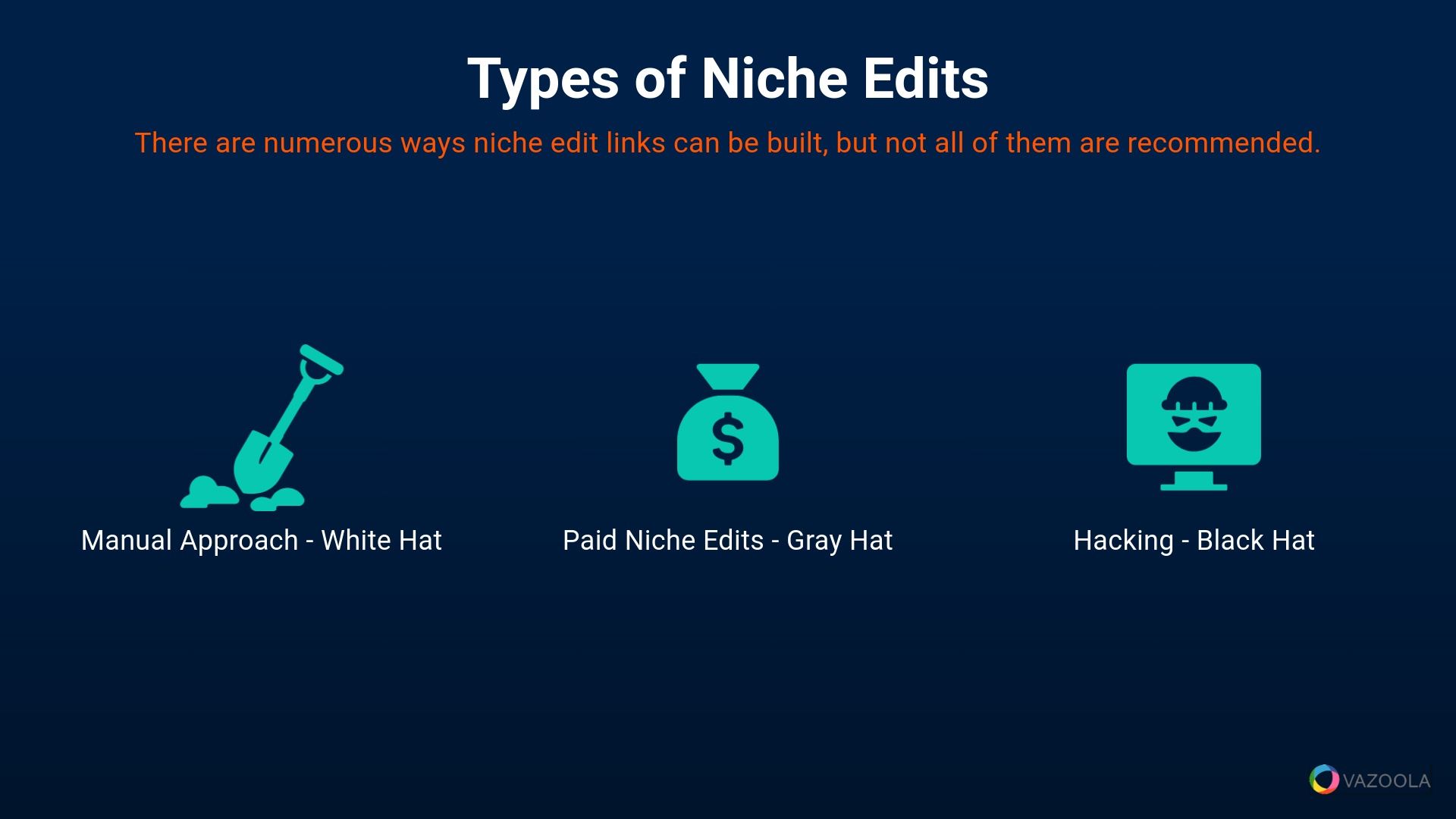
There are a variety of ways to build niche edit, but we don’t recommend them all. Our niche edit services approach the process from a natural, high quality, and cost-effective position.
A niche edits service can be implemented through three main approaches: manual, paid, and hacking.
Manual Approach to Niche Edits (White Hat)
The manual approach, which involves reaching out to webmasters, is the organic and white hat method for obtaining niche edit links.
Although manual niche edits can be time-consuming, the approach is inexpensive. Ideally, you’re trading value for links without any exchange of money.
For example, a local bakery reaches out to a food blogger to include a link to the bakery’s website in a popular post about baking tips. The niche edit enhances their visibility without spending money.
Manual niche edits, however, aren’t without their disadvantages. A small tech startup, for instance, could spend weeks emailing tech bloggers for link placements, only to receive a few responses.
Still, there are pros and cons to building links with manual niche edits:
Pros of Manual Niche Edits
-
Cost-effective: No need to pay for links, just time and effort.
-
High-quality links: Links are placed on relevant, authoritative sites.
-
Natural link growth: Builds credibility and trust with search engines.
-
Relationship building: Establishes connections with webmasters for future opportunities.
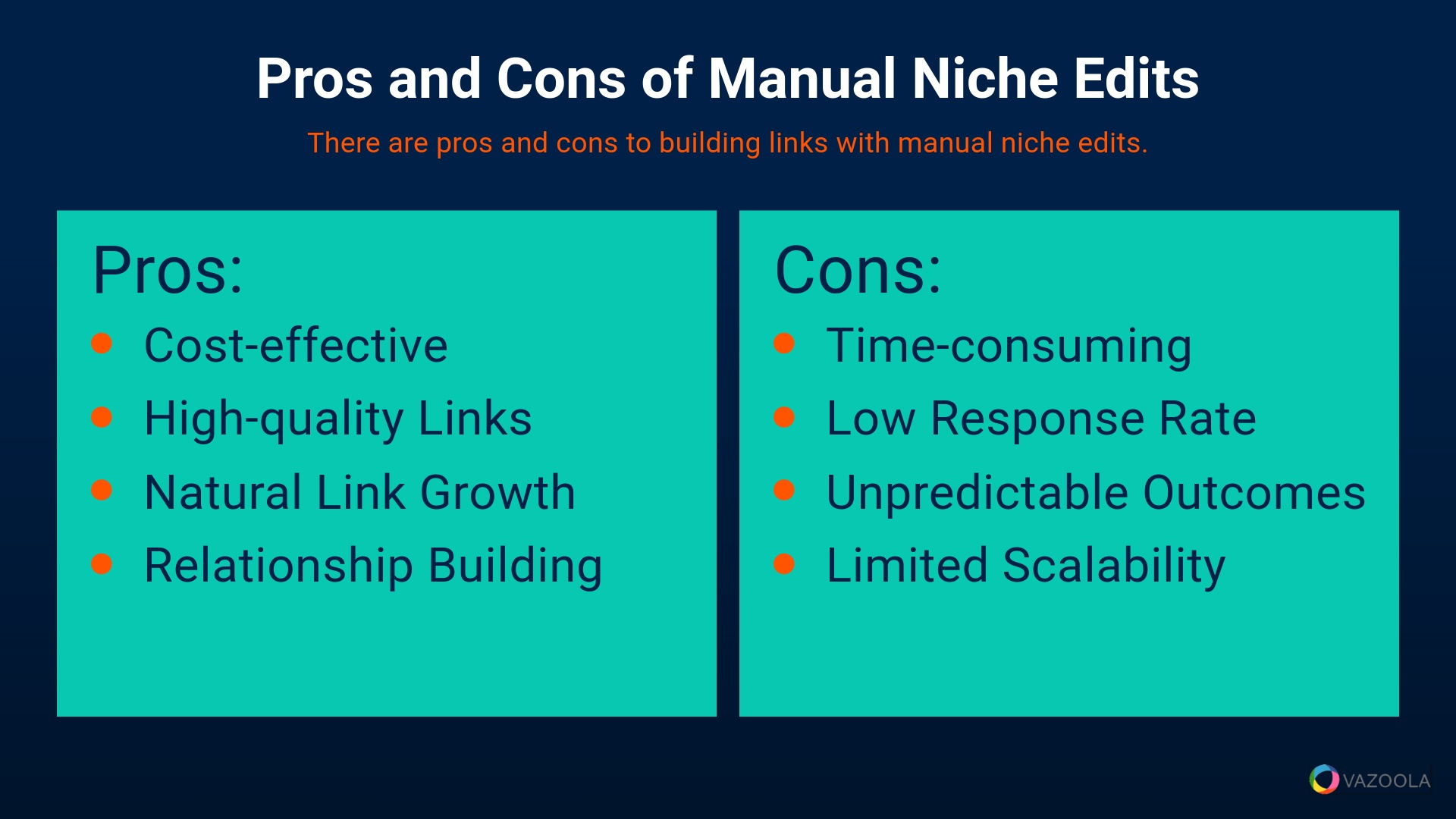
Cons of Manual Niche Edits
-
Time-consuming: Requires significant effort in finding and contacting webmasters.
-
Low response rate: Many outreach attempts may be ignored.
-
Unpredictable outcomes: Success isn't guaranteed, and results can vary.
-
Limited scalability: Harder to scale compared to automated or paid methods.
Pro Tips:
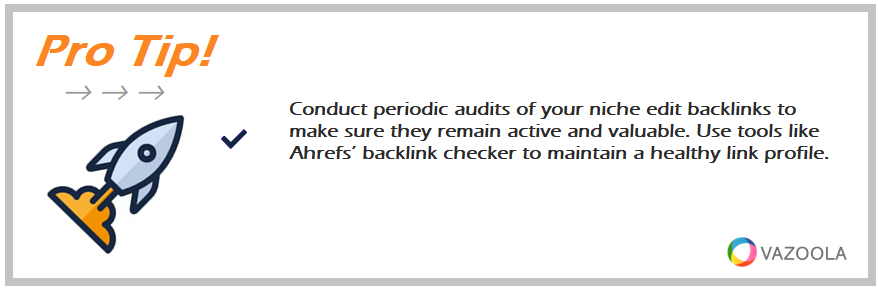
Conduct periodic audits of your niche edit backlinks to make sure they remain active and valuable. Use tools like Ahrefs’ backlink checker to maintain a healthy link profile.
Paying for Niche Edits (Gray Hat)
The alternative to white hat niche edits is the gray hat option – cutting time but spending money. The method of niche edits linking involves offering money for the links.
You can buy niche edits directly from publishers, but it violates Google guidelines. As a result, you risk manual actions being taken against your website. This method should therefore be applied with caution.
A good SEO link building agency will charge a fee for the service, but it will obtain white hat curated niche edits on your behalf. That means the agency will not buy links from webmasters. You can buy white hat niche edits through an SEO agency that will build the links for you.
When working with a niche edit service, make sure the links fit naturally in the posts. Likewise, the links should be relevant to your target page.
The packages or niche edit link pricing are typically based on domain authority and other metrics of the target websites. However, you can still get cheap niche edits links from high-authority websites when working with the right provider.
Hacking for Niche Edits (Black Hat; Not Recommended)
Some methods of obtaining link edits should be avoided at all costs. In fact, they might even amount to theft.
The last and least productive approach is hacking. The niche edits link process involves hacking a web page and conducting link insertions without permission.
With the modern, efficient SEO tools used to regularly track and audit links, it’s often just a matter of time before the web admins spot suspicious links.
Thus, this approach can be a waste of time and money since the links will be removed when the webmaster discovers them.
Guest Posting vs. Niche Edits
Which is better, guest post vs. niche edits?
Guest posts and niche edits are both valuable for link building, but niche edits offer distinct advantages.
Unlike guest posts, which involve creating new content, niche edits target aged and indexed pages or posts.
In the debate between guest posting and niche edits, the speed and efficacy of niche edit services stand out. Niche edits link to existing blog posts, offering quicker access to authoritative domains compared to creating new posts.
Further, niche edits typically cost less than guest posts since they leverage existing content without the need for new creation. This provides brands with a head start in link acquisition and offers a more cost-effective solution for backlinking strategies.
Regardless which is better, a combination of the two tactics offers the greatest benefit. If you have the budget, employ both guest posting and niche edits SEO strategies.
Pro Tips:
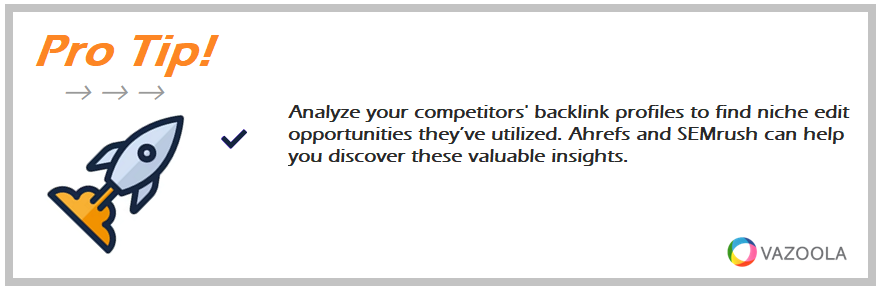
Analyze your competitors' backlink profiles to find niche edit opportunities they’ve utilized. Ahrefs and SEMrush can help you discover these valuable insights.
Blogger Outreach vs. Niche Edits
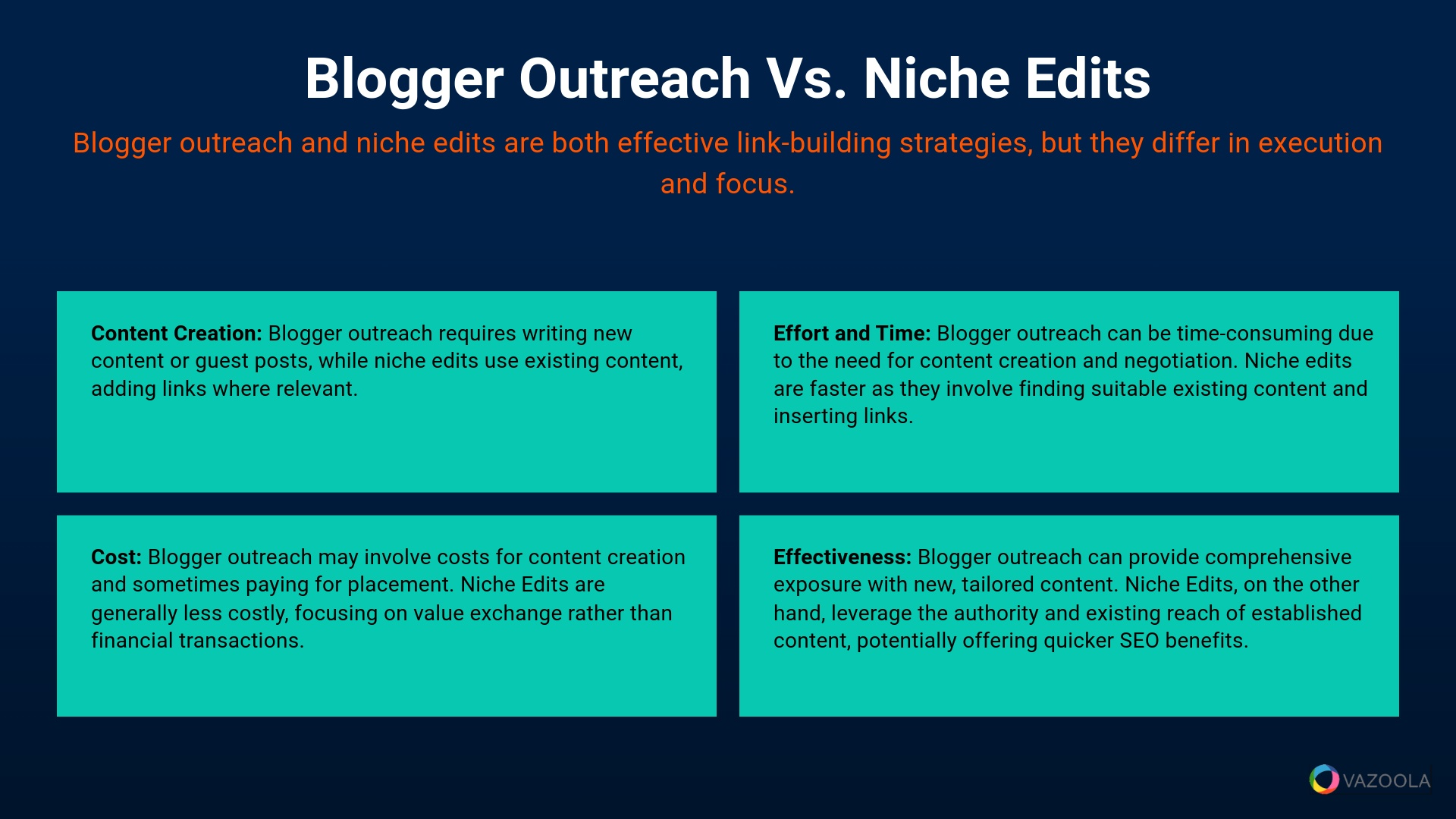
You also can compare niche edits vs. outreach.
Blogger outreach and niche edits are both effective link-building strategies, but they differ in execution and focus.
Blogger outreach occurs when you reach out to bloggers and website owners and request new content or guest posts with a link to your site. The method often requires creating fresh, relevant content that aligns with the host site's audience.
For instance, a tech company might pitch an article about the latest trends in software development to a popular tech blog, including a link back to their website.
Niche edits, on the other hand, require inserting links into existing content on established websites. Rather than creating new articles, you add your link to a relevant, pre-existing post.
For example, a travel agency might have their link added to an existing blog post about top travel destinations. The link boosts their site's visibility through an already trusted and indexed article.
Niche editing can be considered its own niche within the broader scope of blogger outreach. Both strategies are designed to build high-quality backlinks, but niche edits focus on enhancing existing content rather than creating new material.
In what specific ways are niche edits and blogger outreach similar, and how are they different? Consider the following:
-
Content Creation: Blogger outreach requires writing new content or guest posts, while niche edits use existing content, adding links where relevant.
-
Effort and Time: Blogger outreach can be time-consuming due to the need for content creation and negotiation. Niche edits are faster since they involve finding suitable existing content and inserting links.
-
Cost: Blogger outreach might involve costs for content creation and sometimes paying for placement. Niche Edits are generally less costly, focusing on a value exchange rather than financial transactions.
-
Efficacy: Blogger outreach can provide comprehensive exposure with new, tailored content. Niche Edits, on the other hand, leverage the authority and existing reach of established content, potentially offering quicker SEO benefits.
Pro Tips:
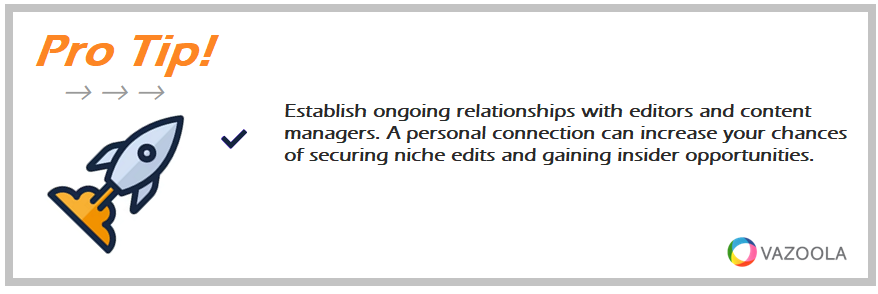
Establish ongoing relationships with editors and content managers. A personal connection can increase your chances of securing niche edits and gaining insider opportunities.
Best Practices for Niche Edit Link Building and Link Insertions
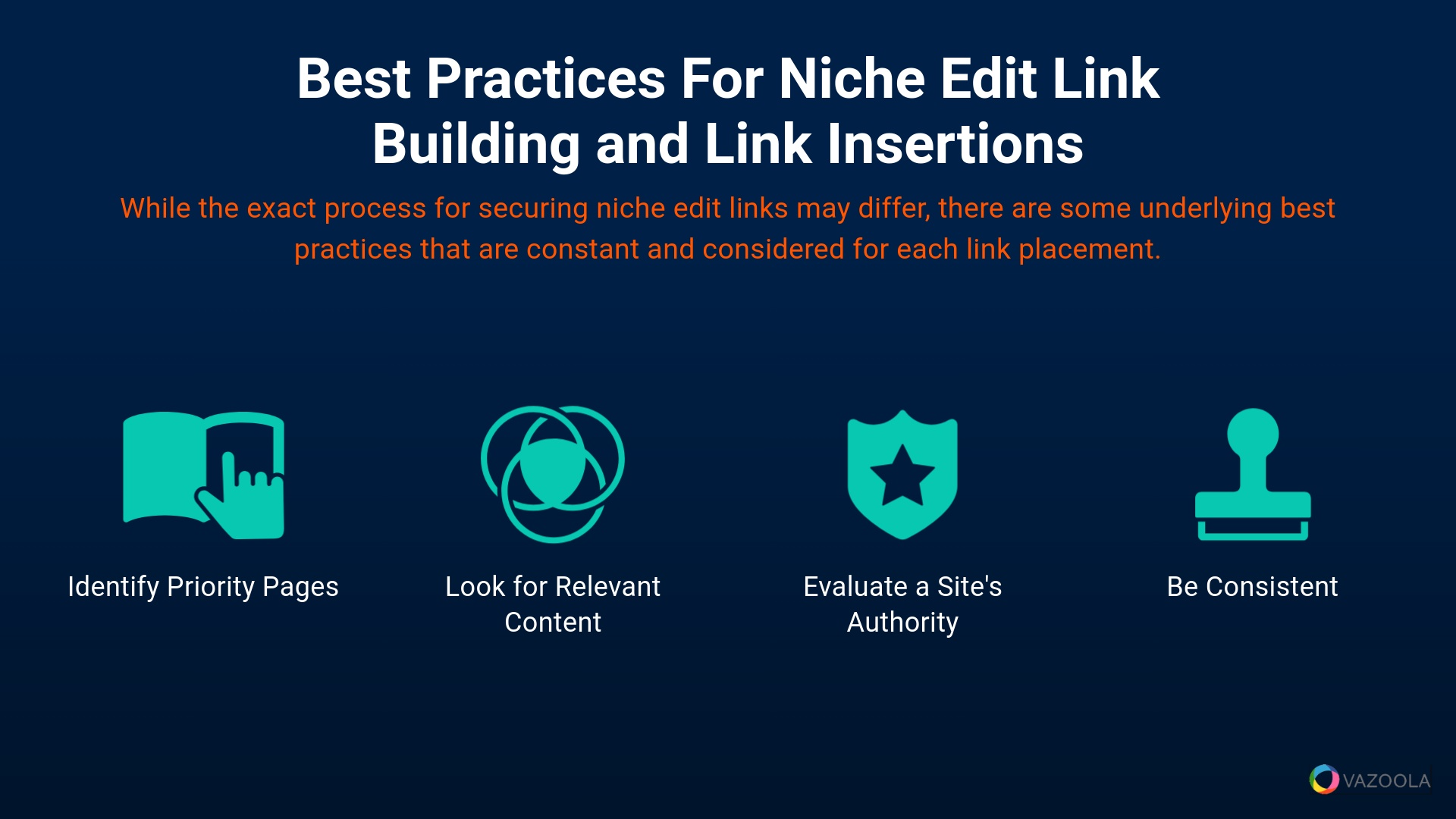
Do you know how to make niche edits? While the exact process for securing niche edit links may differ, there are some underlying best practices involved.
Identify Priority Pages
When buying niche edits, always prioritize existing articles on pages with multiple backlinks.
Pages with a high number of backlinks are generally seen by search engines to be authoritative and trustworthy. They significantly boost the value of your link placement on such sites.
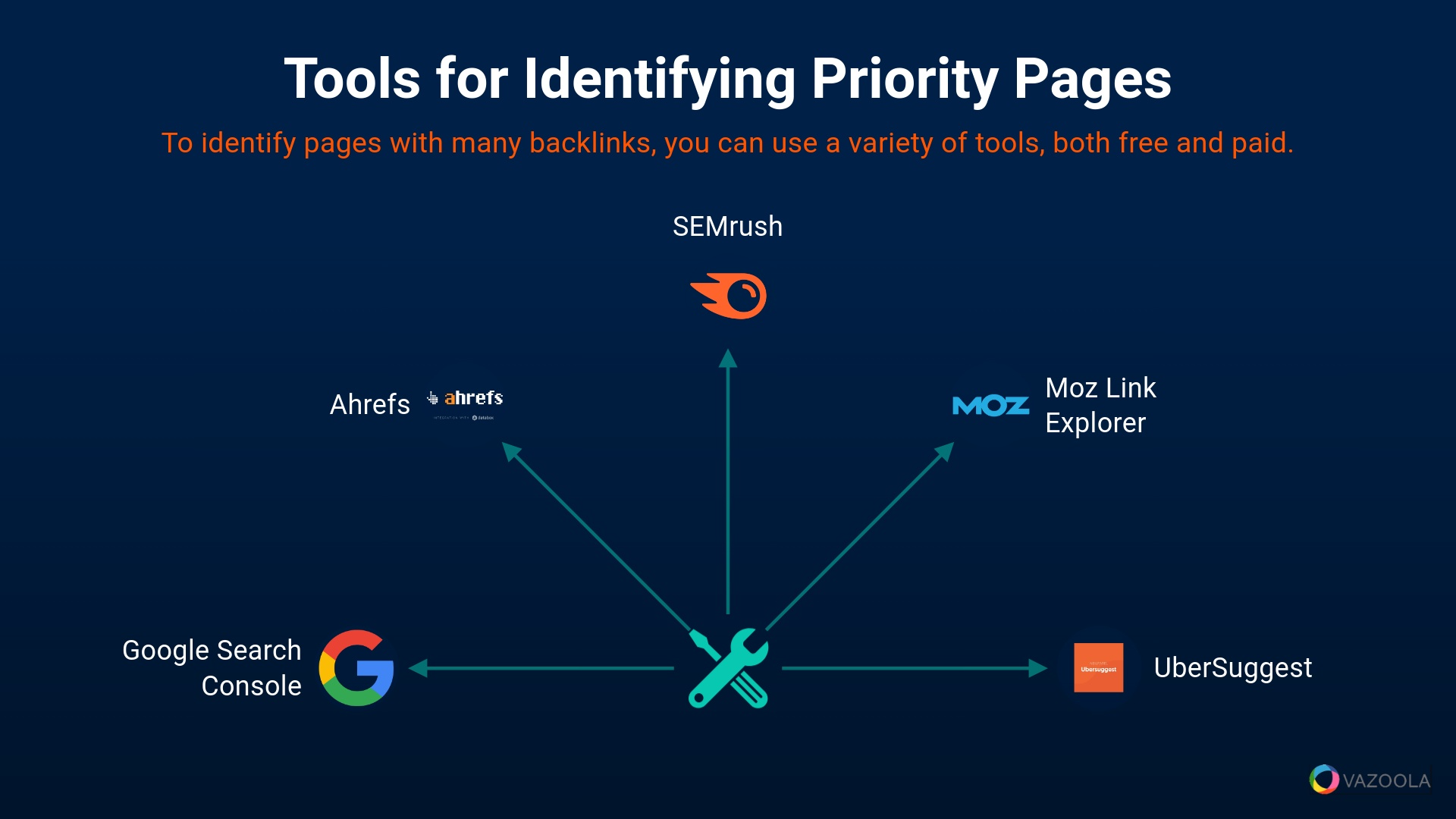
To identify pages with many backlinks, you can use a variety of tools, both free and paid. Here are some effective methods and tools to help you find these valuable pages:
-
Google Search Console: This free tool from Google allows you to see which sites are linking to your content. By analyzing this data, you can identify high-authority pages within your niche.
-
Ahrefs: A paid tool that offers comprehensive backlink analysis, Ahrefs lets users enter a competitor's URL or a topic to see which pages are getting the most backlinks. This action helps pinpoint which pages would be most beneficial for niche edits.
-
SEMrush: Another powerful paid tool, SEMrush provides detailed insights into backlink profiles. You can use it to identify pages with high link authority and many backlinks.
-
Moz Link Explorer: Both free and paid versions are available. This tool allows you to explore a website's backlink profile, identify which pages have the most links, and assess their authority.
-
Ubersuggest: A more budget-friendly option, Ubersuggest offers a good overview of backlink data, which helps you identify pages with substantial link authority.
Pro Tips:
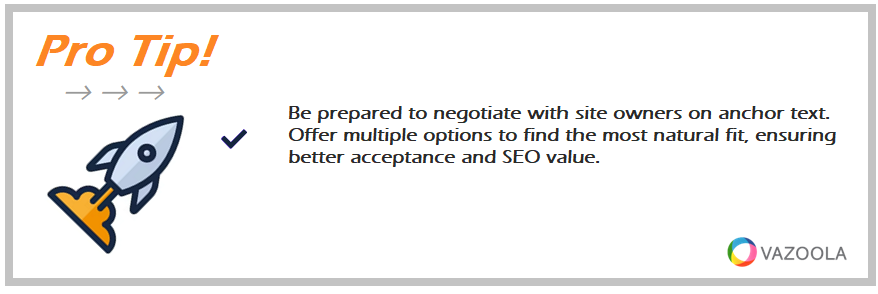
Be prepared to negotiate with site owners on anchor text. Offer multiple options to find the most natural fit, ensuring better acceptance and SEO value.
Look for Relevant Content
When considering a website for niche edits, you have to look for the most relevant pages.
Quality content that is closely related to your page and high authority outbound links (resource links) are good indicators potentially effective niche edits. The goal is always high-quality and relevant content.
To increase the chances of site owners, agree to insert your links, be prepared with surrounding text and a natural anchor text. Preparation makes the process smoother for the publisher.
When you take the time to plan ahead and figure out how to add content value to the existing piece for the site owner, your success rate will significantly increase.
For example, if you run a health supplement store and find an article about "Top 10 Natural Remedies for Better Sleep" on a reputable wellness blog, you should ensure your niche edit request aligns well with the content.
You could suggest adding a link to your page about melatonin supplements within the section discussing natural sleep aids. Likewise, providing surrounding text that smoothly integrates your link will make it easier for the site owner to accommodate your request.
By carefully selecting relevant content and preparing natural, valuable additions, you enhance the likelihood of acceptance, and you make sure your link is contextually appropriate and beneficial to readers.
This strategy fosters a positive relationship with site owners and maximizes the impact of your niche edits.
Evaluate a Site's Authority
Is a site worth your effort?
When targeting sites for link insertions, it's essential to focus on those with strong SEO metrics.
Sites with great domain authority, domain rating, robust page metrics, and plenty of referring domains are ideal. These factors significantly influence how quickly and effectively a link insertion will enhance your SEO efforts.
Domain authority (DA) and domain rating (DR) are two key SEO metrics that help evaluate a site's overall authority. Moz's DA and Ahrefs' DR scores are based on factors like the number and quality of backlinks.
You can check DA using Moz Link Explorer, which offers both free and paid versions. Meanwhile, Ahrefs Site Explorer, a paid tool, provides detailed DR metrics.
Page metrics like URL rating from Ahrefs are also crucial for assessing the strength of individual pages where you want to place your link. Ahrefs provides comprehensive data on UR and backlinks, so it’s an excellent resource for page-level analysis.
Referring domains indicate how many unique websites are linking to the target site – another critical metric. A higher number of referring domains generally means a more authoritative site. Tools like Ahrefs and SEMrush offer detailed insights into referring domains and backlinks.
Estimating organic traffic – even without access to a site's Google Search Console or Google Analytic – is possible using third-party tools. SEMrush and Ahrefs provide estimated organic traffic metrics, while SimilarWeb offers both free and paid options for traffic insights, including organic estimates.
Quality signals like content relevance, user engagement metrics like time on page and bounce rate, and the presence of high authority outbound links are also important. Google Search Console, if accessible, and tools like Ubersuggest can provide valuable insights.
Be consistent
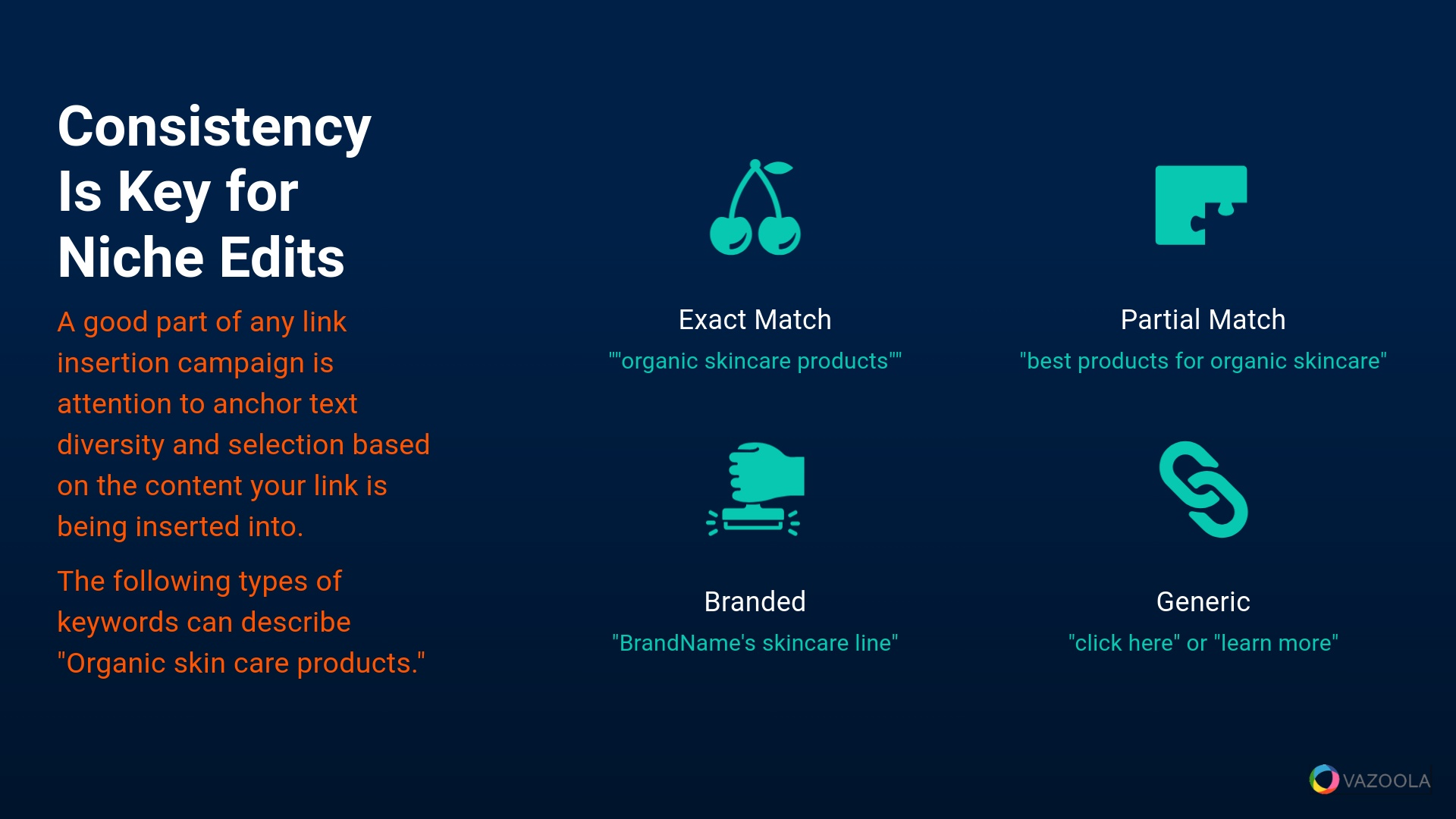
Finally, consistency is key when it comes to using niche edits as a link building strategy. The more often you get link insertions, the better your performance in the search engines.
A good part of any link insertion campaign is attention to anchor text diversity and selection. This is based on the content your link is being inserted into.
Anchor text diversity is crucial for a natural and effective link profile. Using the same anchor text repeatedly can appear spammy to search engines. Thus, it can potentially lead to penalties.
To avoid this negative scenario, vary your anchor text by using a mix of branded, exact match, partial match, and generic terms.
For example, if your target keyword is "organic skincare products," you might use anchor texts like:
-
Exact match: "organic skincare products"
-
Partial match: "best products for organic skincare"
-
Branded: "[Brand Name's] skincare line"
-
Generic: "click here" or "learn more"
Selecting the appropriate anchor text also depends on the context of the content where your link is inserted. The anchor text should fit naturally within the sentence and enhance the reader's experience.
Moreso, maintaining a diverse anchor text profile helps target different keywords and phrases. That way, it spreads your reach across different search queries.
This approach can improve your rankings for a broader set of keywords and make your link profile look more organic and trustworthy to search engines.
Pro Tips:
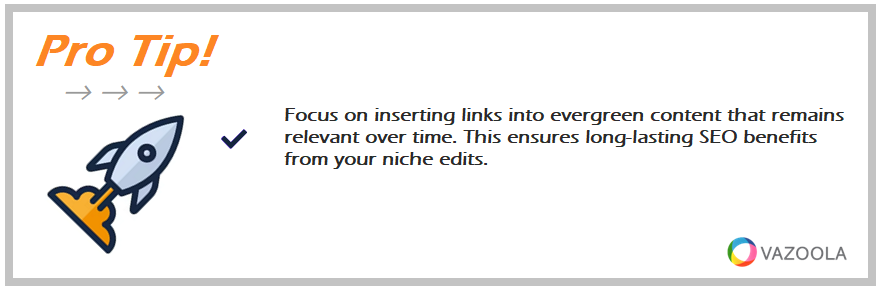 Focus on inserting links into evergreen content that remains relevant over time. This ensures long-lasting SEO benefits from your niche edits.
Focus on inserting links into evergreen content that remains relevant over time. This ensures long-lasting SEO benefits from your niche edits.
Boost Your Site’s Search Rankings with Niche Edits
Incorporating niche edits into your SEO strategy can significantly boost your site's authority and search rankings.
By targeting high-authority pages, using relevant content, and maintaining anchor text diversity, you create a powerful link profile that search engines favor.
Consistent efforts to secure niche edits will lead to sustained SEO benefits. Leveraging these best practices makes your link building strategy effective, natural, and aligned with your overall digital marketing goals.
Pro Tips:
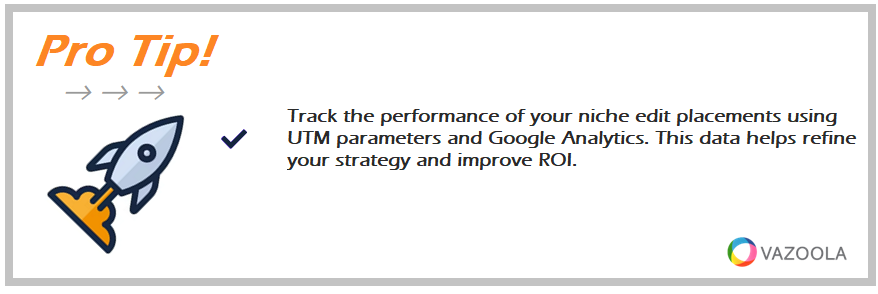
Track the performance of your niche edit placements using UTM parameters and Google Analytics. This data helps refine your strategy and improve ROI.

